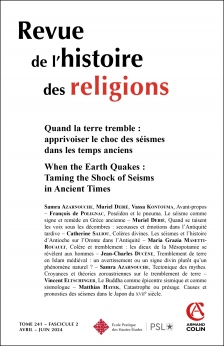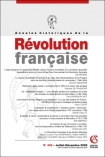
REVUE DE L'HISTOIRE DES RELIGIONS (2/2024)
Pour acheter ce numéro, contactez-nous
Recevez les numéros de l'année en cours et accédez à l'intégralité des articles en ligne.
Si le séisme est avant tout un acte cosmogonique provoqué par l’intrusion du Mal dans le monde d’Ohrmazd, les récits zoroastriens décrivant le phénomène témoignent d’une remarquable confluence de mythes, de théories mécanistes et d’analogies biologiques. La tradition reflétée par les textes (Bundahišn 21e, Dēnkard III.93 et Dādestān ī Dēnīg 69) l’attribue tantôt au démon Čišmag et à ses acolytes atmosphériques, tantôt au sorcier Frāsyāb, deux figures qui ont aussi en commun d’être associées à la sécheresse. Certains épisodes qui les mettent en scène incluent également une mystérieuse apparition de Spandarmad, la déesse de la terre. Ces éléments indiquent que l’étiologie zoroastrienne des séismes était bien plus complexe et plus narrative que ce que les textes transmis jusqu’à nous donnent à voir.
While the earthquake is primarily a cosmogonic act provoked by the intrusion of Evil into Ohrmazd’s world, the Zoroastrian accounts describing the phenomenon also bear witness to a striking confluence of myth, mechanistic theories and biological analogies. The tradition conveyed by the texts (Bundahišn 21e, Dēnkard III.93 and Dādestān ī Dēnīg 69) attributes the earthquake sometimes to the demon Čišmag and his atmospheric acolytes, sometimes to the sorcerer Frāsyāb, two figures who also have in common that they are associated with drought. Some episodes featuring them also include a mysterious appearance by Spandarmad, the Earth goddess. These elements indicate that the Zoroastrian aetiology of earthquakes was far more narratively complex than the texts handed down to us give us to understand.

